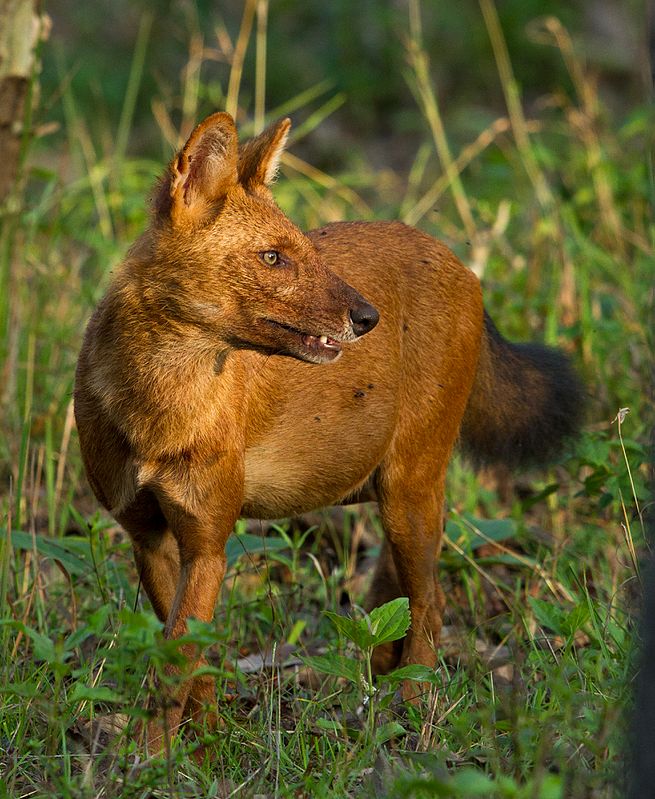
-
Dhole
The dhole (Cuon alpinus) is a canid native to Central, South and Southeast Asia. Other English names for the species include Asiatic wild dog, Indian wild dog, whistling dog, red dog, and mountain wolf. It is genetically close to species within the genus Canis, though its skull is convex rather than concave in profile, it lacks a third lower molar and the upper molars sport only a single cusp as opposed to two to four. During the Pleistocene, the dhole ranged throughout Asia, Europe and North America but became restricted to its historical range 12,000–18,000 years ago.The dhole is a highly social animal, living in large clans without rigid dominance hierarchies and containing multiple breeding females. Such clans usually consist of 12 individuals, but groups of over 40 are known. It is a diurnal pack hunter which preferentially targets medium and large sized ungulates. In tropical forests, the dhole competes with tigers and leopards, targeting somewhat different prey species, but still with substantial dietary overlap.It is listed as Endangered by the IUCN as populations are decreasing and are estimated at fewer than 2,500 adults. Factors contributing to this decline include habitat loss, loss of prey, competition with other species, persecution due to livestock predation and disease transfer from domestic dogs.
-
Wolf
The wolf (Canis lupus), also known as the gray wolf, timber wolf, western wolf, and its other subspecies is a canine native to the wilderness and remote areas of Eurasia and North America. It is the largest extant member of its family, with males averaging 43–45 kg (95–99 lb) and females 36–38.5 kg (79–85 lb). Like the red wolf, it is distinguished from other Canis species by its larger size and less pointed features, particularly on the ears and muzzle. Its winter fur is long and bushy and predominantly a mottled gray in color, although nearly pure white, red, and brown to black also occur. Mammal Species of the World (3rd ed., 2005), a standard reference work in zoology, recognises 38 subspecies of C. lupus..
The gray wolf is the second most specialised member of the genus Canis, after the Ethiopian wolf, as demonstrated by its morphological adaptations to hunting large prey, its more gregarious nature, and its highly advanced expressive behavior. It is nonetheless closely related enough to smaller Canis species, such as the eastern wolf, coyote, and golden jackal, to produce fertile hybrids. It is the only species of Canis to have a range encompassing both the Old and New Worlds, and originated in Eurasia during the Pleistocene, colonizing North America on at least three separate occasions during the Rancholabrean. It is a social animal, travelling in nuclear families consisting of a mated pair, accompanied by the pair’s adult offspring. The gray wolf is typically an apex predator throughout its range, with only humans and tigers posing a serious threat to it. It feeds primarily on large ungulates, though it also eats smaller animals, livestock, carrion, and garbage. A seven year-old wolf is considered to be relatively old, and the maximum lifespan is about 16 years.The gray wolf is one of the world’s best-known and most-researched animals, with probably more books written about it than any other wildlife species. It has a long history of association with humans, having been despised and hunted in most pastoral communities because of its attacks on livestock, while conversely being respected in some agrarian and hunter-gatherer societies. Although the fear of wolves is pervasive in many human societies, the majority of recorded attacks on people have been attributed to animals suffering from rabies. Non-rabid wolves have attacked and killed people, mainly children, but this is rare, as wolves are relatively few, live away from people, and have developed a fear of humans from hunters and shepherds.
-
Dhole (noun)
An Asian wild dog, Cuon alpinus.
-
Wolf (noun)
The gray wolf, specifically all subspecies of the gray wolf (Canis lupus) that are not dingoes or dogs.
-
Wolf (noun)
A man who makes amorous advances to many women.
-
Wolf (noun)
A wolf tone or wolf note.
-
Wolf (noun)
One of the destructive, and usually hairy, larvae of several species of beetles and grain moths.
“the bee wolf”
-
Wolf (noun)
Any very ravenous, rapacious, or destructive person or thing; especially, want; starvation.
“They toiled hard to keep the wolf from the door.”
-
Wolf (noun)
A white worm, or maggot, which infests granaries.
-
Wolf (noun)
An eating ulcer or sore. See lupus.
-
Wolf (noun)
A willying machine.
-
Wolf (verb)
To devour; to gobble; to eat (something) voraciously.
-
Wolf (verb)
To make amorous advances to many women; to hit on women; to cruise for sex.
-
Wolf (verb)
To hunt for wolves.
